

 The South African
The South African
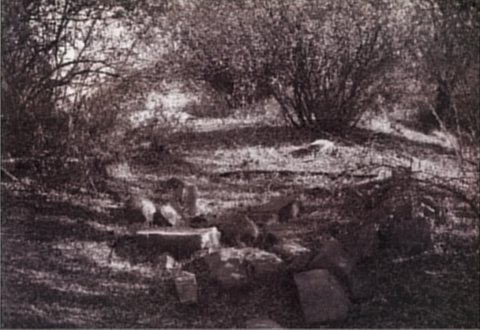
The original burial place of the four men of the 5th Queensland Imperial Bushmen killed at Mokari Drift
on 27 September 1901- Lieutenants A E Pooley and L J Caskey, and Privates B Milner and G H White.
Van Stadensrus is a small obscure Free State town near the border with Lesotho. In the local cemetery four Australian soldiers lie buried. One of them has a handsome marble cross headstone with an inscription on the plinth which reads 'In loving memory of my dear son Lachlan John Caskey. Killed at Mokari Drift 27th Sept 1901. Erected by his mother.' Next to it are the remains of what may once have been a glass-fronted wooden headstone with an inscription for Alfred Ernest Pooley. The glass is long gone and the inscription, too, is missing. Beside these two memorials are two small pieces of wood, all that remains of the wooden crosses that once graced the last resting places of Benjamin Milner and George Henry White. (These names are given in Steve Watt, In Memoriam, and in the official South African War Casualty Roll. Also listed are Lance Corporal J J Hall and Private J T Gatfield, both severely wounded, Private T Paton, slightly wounded, and Private F W Window, who fell from his horse.)
Caskey, Pooley, Milner and White were casualties of a skirmish with the Boer commando of Commandant Louis Wessels (part of the larger force commanded by General Pieter Kritzinger) on the farm, Dewetsdal, on the Caledon River. Originally buried in the garden of the farmhouse on Mokari farm, they were reinterred in Van Stadensrus in the 1960s during the programme of consolidating farm graves into cemeteries or Gardens of Remembrance in the nearest town. The remote graveyard where they lie will likely preserve what remains for another century. Details of the Boer casualties during the skirmish are unknown, although there must surely have been some in what was a fierce fight typical of the minor actions of that period of the Anglo-Boer War, when British columns scoured the countryside for their elusive enemy.
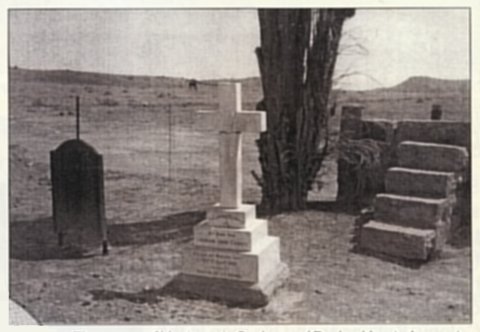
The graves of Lieutenants Caskey and Pooley, Vanstadensrus
In August and September 1901 there was considerable military activity in the south-eastern Orange River Colony (the new name for the Orange Free State under British occupation) as the British attempted to locate and capture the commando of Assistant Commandant-General Jan Smuts, heading for the Cape Colony. Taking a sizeable commando from the Transvaal through the Orange River Colony was no easy task but Smuts made it safely to his meeting place with General Pieter Kritzinger at Zastron in the south-east, where Kritzinger was to provide guides for the crossing of the Orange River. Kritzinger had been driven out of the Cape only two weeks previously and certainly had valuable information for Smuts concerning the whereabouts of the enemy forces over the river (Reitz, 1929, pp 200-202).
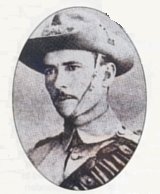
Lt Lachlan John Caskey
Orange River crossing
Smuts and his commando of about 350 men crossed the Orange at Kiba Drift, some way upstream from Aliwal North, on the night of 3 September or early in the morning on the following day. Accompanying him for a few days was Commandant Louis Wessels and fifty of his men, among whose numberwas an old veteran of the Basuto wars of the previous century, who pointed out the crossing place overthe river. The British had guarded every drift (but one, perhaps?) and Kritzinger was left behind at Zastron to divert any pursuit of Smuts, with the intention of joining him later with reinforcements. In Commando, Reitz correctly names the leader of the guiding party as Commandant Louis Wessels. The name of the old veteran guide was Piet Wessels (See also Shearing, 2000, p 26).
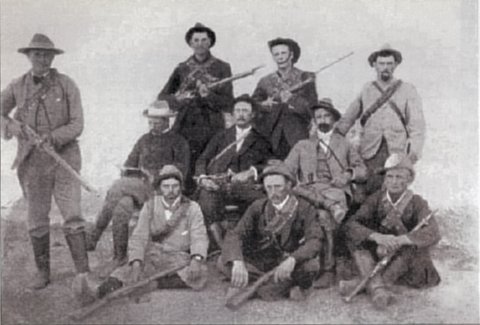
Commandant Louis Wessels (seated, centre), the leader of a Boer guiding party
This small concentration of Boers Smuts and Kritzinger together mustered scarcely more than 600 men - caused the British to rush troops to the area from all quarters. Although Smuts and most of his men had managed to evade capture and cross into the Cape Colony, Kritzinger and his men in the Zastron area were a threat that the British needed to eliminate. MajorGeneral Fitzroy Hart was in command of a section of river from Aliwal North to the Basutoland border. He really had insufficient troops to guard every drift, but there were, in addition, three other British columns in the area to the north of him under Colonels Rawlinson and Thomeycroft and Brigadier-General Plumer (Amery, Vol V, p 318; Maurice, Vol 4, p 286).
Kritzinger was able to avoid the attentions of the columns and, from 'Vecht Kop', a high hill to the east of Zastron, observed his enemy's movements. Guarding the drifts overthe Orange at Quaggafontein was Lt-Col the Honourable A Murray with a force that included a number of Loval's Scouts, a Yeomanry company raised by Lord Lovat largely from his estate in Scotland. Major Lord Lovat and a detachment were occupied chasing Smuts across the river, leaving Murray with only 106 men spread over a number of pickets around his camp. The Yeomen were unable to resist an onslaught by Kritzinger's commando around midnight on 20 September. Murray and eleven ofthe Loval's Scouts were killed, as well as eight gunners ofthe 38th Battery, Royal Field Artillery. Kritzinger's men retired back towards Rouxville with a number of horses, rifles and ammunition and an Armstrong gun (Maurice, Vol 4, pp 288-9; Kritzinger, 1904,p34).
By attacking the camp, Kritzinger had revealed his presence. Boer tactics were to split into smaller groups and head off in different directions. The countryside along the Basutoland border provided a multitude of mountain fastnesses with kloofs and ravines where they could stay out of sight for a while. One ofthe Boer groups headed north with the captured gun and was spotted by the scouts of Colonel Thorneycroft's column. About forty Boers were subsequently attacked by the men of Thorneycroft's Mounted Infantry. They abandoned the gun at the roadside and were cornered in a donga on the farm, Florence (Maurice, Vo14, p 318; Kritzinger, 1904, p 36).
Another group of Boers, probably no more than eighty in number, also headed north. They crossed overto the right bank of the Caledon River and set up a laager on top of a high hill on the farm, Sweetfontein. The summit of the hill was in the shape of a bowl. Small streams provided water and they were able to see far in every direction. They seemed to be safe from detection while they awaited word from Kritzinger about rejoining him for his next foray into the Cape Colony. Their commandant was Louis Wessels, who had returned from guiding Smuts and had played a prominent part in the attack on Lovat's Scouts at Quaggafontein. Wessels was described by Kritzinger as 'certainly one of the most intrepid and fearless officers of the whole Boer army' (Kritzinger, 1904, p 71).

Boer General Pieter Kritzinger
Plumer's Column
Brigadier Herbert Plumer's column had been in the vicinity of Zastron and further north, near Wepener, since early September. Plumer was well-liked by his Colonial troops, Australians and New Zealanders, which was something of a rarity for a British officer. Before the war, he had come to South Africa several times from 1894 onwards and, during the relief of Mafeking, he had been a lieutenant-colonel. His column consisted of 980 men, including Australians, New Zealanders, gunners of the Royal Field Artillery, men of the 7th Mounted Infantry (Royal Hampshire Regiment) from England, and some Scottish Yeomanry. (The formal rank of brigadier-general was not established yet in the British Army and therefore it was a local or temporary appointment granted typically to a full colonel when commanding a brigade or column at this stage of the war [Plumer's column is described in Fogg, Chapter 4, p 2; Maurice, Vo14, p 269; and Amery, Vol V, p 385]).
The Australians were the 5th Queensland Imperial Bushmen (QIB), mostly from the country districts of Queensland. They would have had much in common with their Boer adversaries. It had become clear to the British, once the war became a conflict with bands of highly-mobile Boer guerilla fighters, that they needed mounted scouts skilled in bushcraft. The Australian Bushmen were good riders and trackers, able to live off the land and endure harsh conditions, all traits that should make them equal to the Boers in those respects. Most of them were from the bush, but there were also a good many town boys among them. They were all fired up with the patriotism of the day and were keen to fight the Empire's foes, but with barely a month's military training, they were hardly a match forthe Boers, by then hardened after having lived nearly two years in the veld with only their horses and rifles. By contrast, the QIB's marksmanship does not seem to have been very good. They expended thousands of rounds in engagements with the Boers in order to inflict quite moderate numbers of casualties. Nevertheless, they were physically much stronger than their British counterparts and this meant that they generally gave a good account of themselves (Fogg, Chapter 2, p 7).
In the 5th QIB were a number of interesting individuals. Two young brothers, David and William Lilley, had joined the regiment, David, the elder brother being an acting corporal and William, a private. The younger brother was only seventeen, so David was encouraged by his parents to 'keep an eye on William'. (This story is told by Alan Lilley, 'Only one brother returned from the war', on the 'Australians at War' website). One of the officers was a Brisbane teacher, Lachlan John Caskey, who was a lieutenant in 'K' Company of the QIB. He was almost thirty-one years old when he arrived in South Africa and had been a teacher at a boys' school where inspectors had described him as 'very hardworking and energetic, not intellectual' (Peter Doherty, 'Lachlan John Caskey, 1870-1901', article concerning the memorial to Lt L J Caskey). Another lieutenant was Alfred Ernest Pooley who had been a sergeant-major in the 4th Queensland Contingent, had returned home from service and had then volunteered for another tour of duty, this time being promoted to officer's rank. Pooley had been born in England and emigrated to Australia in the 1890s.
The column had been moved from the eastern Transvaal (now Mpumalanga) to arrive in Bloemfontein on 18 July 1901. By the end of August they had moved south, patrolling along the Orange River. Marching to Priors Siding on the main railway line, it seemed as if they were about to be returned to the eastern Transvaal. After an inspection by the Medical Officer, they were ordered to march eastwards as part of the force trying to prevent Smuts from crossing into the Cape Colony. After learning that Smuts had succeeded in crossing the Orange River, they focused their attention on Pieter Kritzinger, but he proved very difficult to locate (Fogg, Chapter 9, p 1; Maurice, Vo14, pp 317-8).
From Priors, Plumer led his men towards Rouxville and they camped for the night at Jakkalsfontein, near Smithfield. They headed north, cooperating with other columns around them, and reached Wepener on 13 September without seeing any sign of Kritzinger or Wessels - but no doubt the Boers were aware of the British presence. The QIB patrolled in the area for three days and then the column turned south and arrived back at Rouxville on 22 September, expecting to catch sight of the Boers moving northwards after their success at Quaggafontein. The British seemed to be in a good position to capture the remnants of Kritzinger's commando, who were scattered around the area after Thorneycroft's success at Florence on the evening of 20 September (Fogg, Chapter 9, pp 4-5).
New orders
In Rouxville, however, Plumer received an order that sent him hurrying back northwards. On 19 September, a small British force consisting of mounted infantry ofthe Bedfordshire Regiment and two guns from 'U' Battery RHA left their camp at Boesman's Kop, due east and some ten miles (16 km) from Bloemfontein, and headed south to attack a Boer commando on the farm, Vlakfontein. Finding this farm unoccupied they advanced towards another farm, Siangfontein, where they were attacked by the Boers, who were in positions that the British were unable to counter-attack.
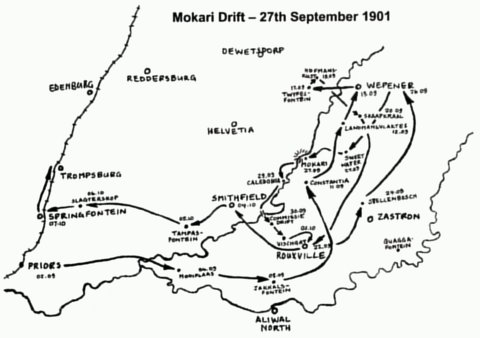
Col H.B Plumer's column: Movements during September 1901.
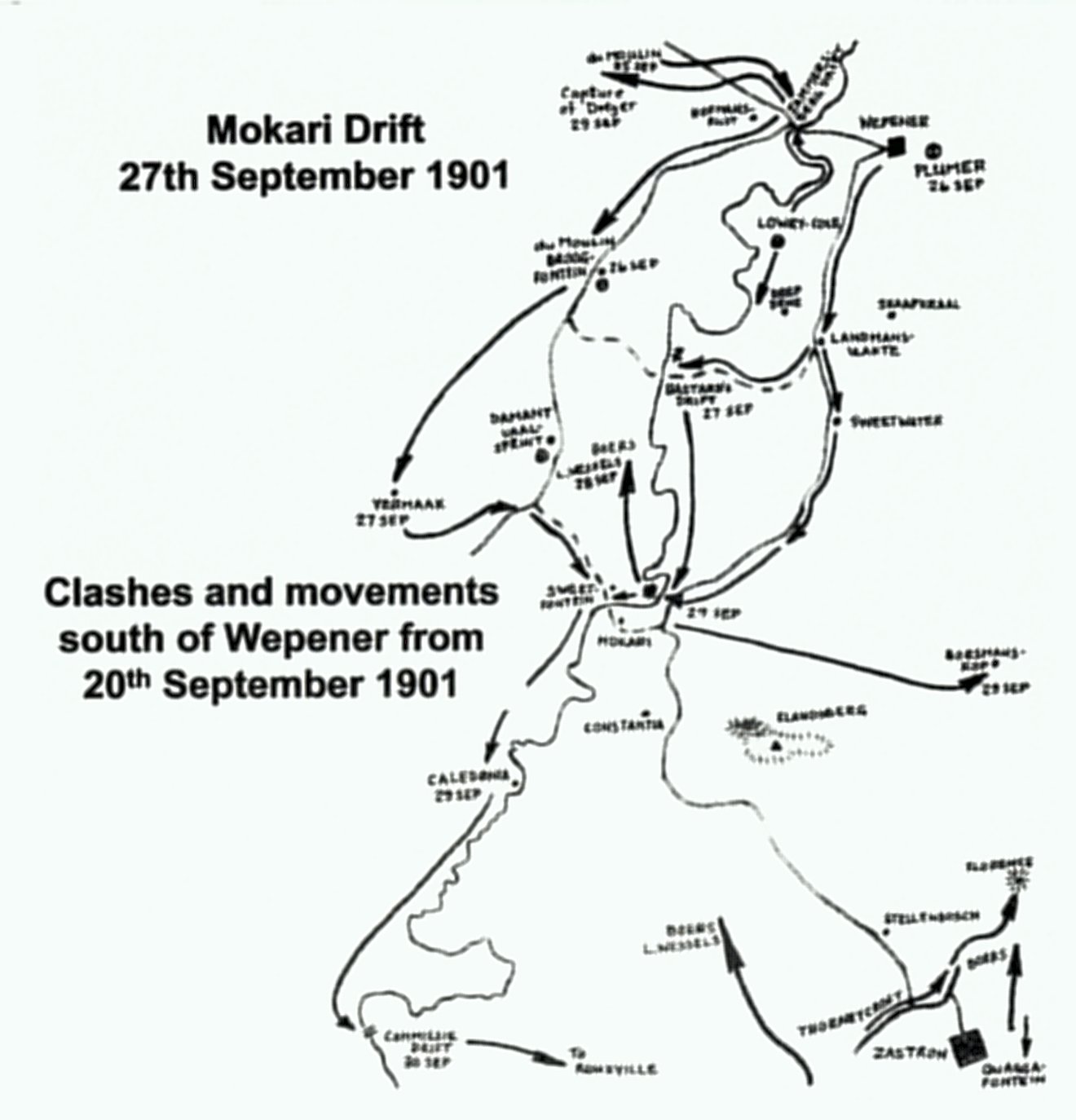
Clashes and movements
The commander was a militia officer, the two guns were in the charge of the young Lt Otter-Barry, and the foray was made without the order of higher authority. There were only 35 Boers involved in the attack on nearly 170 British soldiers. Otter-Barry was killed and the two guns were lost. With an officer and five men killed, 17 men wounded and 94 taken prisoner, 'the whole affair. .. must be regarded as highly discreditable' for the British. Lord Kitchener, in Pretoria at the time, must have been considerably irked by the news of the skirmish. He urged that every effort be made to recover the guns and to find Commandant R C Ackerman and his men. (See Maurice, Vol 4, pp 318-9; Amery, Vol V, p 386. Authors J C Loock and P H Roodt [2005] provide a very different, detailed account of this engagement).
Plumer had time only to restock his wagons before his column marched out again in the afternoon, marching northwards most of the night. Early on 24 September, they were at the farm, Stellenbosch, where they sighted some Boers but were unable to overtake them. With the hard marching that had kept them on the move continuously for seven days, their horses were nearing exhaustion. On Thursday, 26 September, they entered Wepener again and there Plumer met with Lieutenant-Colonel Lowry-Cole whose orders were to guard the crossings of the Caledon River from Jammersberg southwards. There was a report that a force of Boers, about 200-strong, had passed between Plumer and Lowry-Cole the previous night. Plumer managed to get in touch with Lt-Col Louis du Moulin, who had been rushed to Slangfontein and had continued on to Jammersberg. He had discovered what looked like a new grave at Slangfontein which was found to contain 57 of the rifles captured in the debacle of 19 September. Clearly the British were expecting to find a large commando responsible for the attack on Slangfontein, not just a few stragglers who were the actual force, and it is unlikely that Du Moulin would have encountered anyone in his sweep towards Jammersberg Drift. He left before Plumer arrived in Wepener and spent the night at Droogfontein on the road from Bastard's Drift (Maurice, Vol4, p 319; Du Moulin, 1907, pp 278-9). Du Moulin was at Jammersberg Drift on 25 September, the day before Plumer arrived there.
Plumer's plan was to make a sweep southwards on the left bank of the Caledon River and his orders to Du Moulin were to take his force southwards along the right (or western) bank of the river. It was expected that the Boers would cross the river at one of the drifts the next day. A night patrol left Wepener on the evening of Thursday, 26 September. It comprised fifty men of the 7th Mounted Infantry (Hampshire Regiment), fifty men of the 5th Queensland Imperial Bushmen under Lieutenant William Hunter, fifty New Zealand Mounted Rifles and fifty Imperial Yeomanry under the overall command of Major A W Andrew. This was one of Plumer's usual tactics and the patrol was to reconnoitre the drifts over the Caledon for the column to cross the following day (Chamberlain and Drooglever, 2003, p 500, quoting a letter by Trooper A W Walker). Major Andrew was seconded from the Indian Army, commanded the New Zealand 10th Contingent which arrived in South Africa as the war was ending, and eventually attained the rank of brigadier-general in the Great War, 1914-18 (Hall, 1949, p 58).

Opening moves Mokari Drift - 27th September 1901
The patrol marched through the night and camped at 03.00 'about a half-mile from the drift' (ie Bastard's Drift). Major Andrew sent nine men of the 6th NZMR under a Corporal Hemphill to the river, where there was a wagon drift. Clearly expecting to find it occupied by Du Moulin's men on the other side, they ran into some Boers who opened fire and Hemphill's horse was shot. Trooper I E Baigent turned his horse around, took Hemphill up onto his own horse and rode to safety under heavy fire. This type of brave deed would have merited the award of a Victoria Cross but only a Distinguished Conduct Medal was awarded instead. This engagement held up Andrew's force for some hours and Lieutenant P L Tudor's New Zealanders eventually secured the drift (Hall, 1949, p 60). Today, Bastard's Drift lies beneath the waters of the Welbedacht Dam.
The Boers at the drift were probably a picket sent by Wessels at Sweetfontein to make sure that he would not be surprised and attacked from the rear. Major Andrew sent forward the 5th QIB to the next drift, Mokari (the Basuto name for the Caledon River), where there was a recognised crossing point that had been in use since the first Boer settlers arrived in the area in the 1830s. Lieutenant Hunter was in command with his own 'M' Company, Lieutenant Jack Caskey with 'K' Company and Lieutenant Alfred Pooley with 'L' Company. According to a letter by Lt J Loynes, this little force arrived at Mokari Drift around noon on Friday, 27 September (quoted in Chamberlain and Drooglever, 2003, p 498). During a subsequent Court of Enquiry, all witnesses to the incident declared that it was 'about noon'.
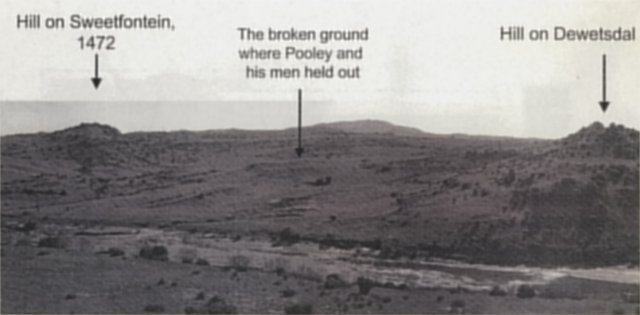
Scene of the battle. This is the view from Lt Hunter's position on a kopje overlooking the Caledon River
Mokari Drift action
Between Mokari, on the eastern or left bank of the river, and Sweetfontein and Dewetsdal opposite and upstream from the actual drift, there is another place where the river can easily be forded unless the water is unusually high. Hunter, in the lead, led his men up onto a small koppie overlooking that spot, a wise and cautious step to take in view of the small force that he had with him. From there, they noticed a number of Boers walking around on a koppie on the other side of the river. Hunter seems not to have given the order to cross the river to investigate, as he told the Court of Enquiry some days later that he saw Lieutenants Caskey and Pooley going very fast on his left and heading in the direction of the drift. They had decided to investigate the Boers on the western side and crossed over the drift towards a semi-circle of koppies. Caskey had clearly assumed that Du Moulin was nearby on the other side of the river and that these Boers might have scattered to avoid an attack by him. In fact, Du Moulin had diverted westwards and was then some distance away, near the farm 'Vermaak' (Fogg, Chapter 10, p 1; Maurice, Vol 4, p 320).
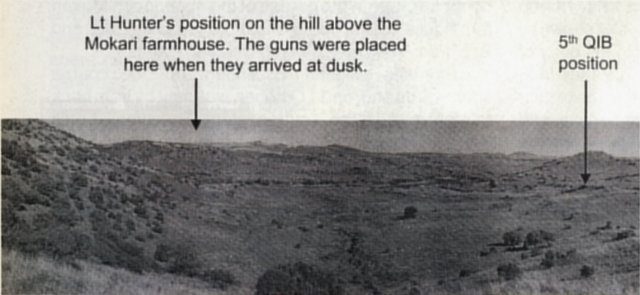
The view from one of the Boer positions on Dewetsdal. In launching their attack, the Boers
made good use of the donga as well as another on the other side of the 5th QIB position.
Almost immediately, Caskey and Pooley came under fire from the hill on their right and galloped hard for some broken ground about 500 yards (460 metres) ahead of them. The seven Boers that they had seen turned into a force of about fifty and Caskey and Pooley and their men had to seek shelter in the broken ground between the two hills. Pooley went to the left with eleven men who were able to occupy some low rises and keep out ofthe direct line offire. Caskey went to the right with Private D Maloney and was fired on from the front and then from behind as well. He said to Maloney, 'They seem to be all around us - hold my horse' and, as he dismounted, he was shot through the chest and killed. Maloney kept firing, but surrendered when the Boers advanced to within 25 yards (23 metres) of him.
Pooley's men returned fire but the Boers gradually surrounded them using the broken ground and several deep dongas. They ran short of ammunition but Lieutenant Loynes describes how two men of the 7th MI (Hampshire Regiment) managed to get across the river with two haversacks full of ammunition. Fifty of the MI had arrived from Bastard's Drift after Hunter had sent a message by heliograph that they were under fire. Some forty Boers were seen galloping from the koppie on the right, which is on Dewetsdal, across to the slightly higher hill to the left, on Sweetfontein. Besides firing down into the broken ground sheltering the Australians, they descended the hill and used the cover of a donga to approach to within a few yards of their adversaries. The Boers came closer and closer, but the QIB 'fought like demons at bay'. Paton was shot in the arm and Gatfield received a bullet through the ankle, which shattered the bone. The Boers called on them to surrender. Pooley was shot through the head by the Boer commandant, using a Mauser pistol.

This photograph, with Lt Hunter's position on the prominent kopje, shows
where Lts Caskey and Pooley and their men crossed the Caledon River.
'Our gallant little crowd - only nine strong - kept at them refusing to surrender when called upon. White stood up to get a shot and actually got six bullets into him ... Milner was shot some distance to the front... racing for cover.' With only twenty rounds left, the survivors gave up and handed over their rifles and bandoliers to the Boers. The prisoners were stripped of all their clothing and possessions, rifles, bandoliers, trousers, hats and one man even said that they took his razor. Wessels told them: 'Never since I have been fighting have I seen such dogged resistance as shown by you men, and as for that man (pointing to the body of Pooley) he is the bravest man I have seen.' After dark, the prisoners were released, one at a time, to make their way back to their own side. (Chamberlain and Drooglever, 2003, pp 497-501, quoting graphic descriptions of the fight on Dewetsdal from letters by Lieutenant J Loynes and Trooper A W Walker). It is estimated that the fight lasted for about five hours.
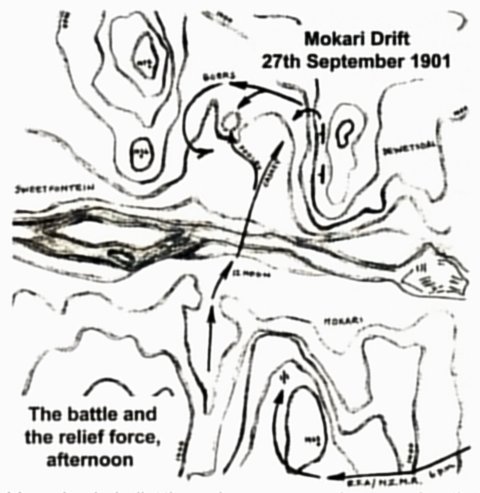
The battle and the relief force
It took some time before substantial reinforcements arrived, as Hunter had insufficient men to tackle the Boers across the river. He heliographed messages to Major Andrew at Bastard's Drift, who, in turn, contacted the column which had only left Wepener that morning. Major Andrew had fewer than 150 men and was concerned about a Boer attack from across the drift. Plumer sent the rest ofthe QIB, with two guns and a pom-pom, to gallop the ten or twelve miles (16-20 km) to Mokari. 'And such a gallop!' enthused Lieutenant Dods in a letter published in the The Brisbane Courier, 27 November 1901, '[o]ur horses were pretty well done, but they kept going remarkably well, urged on by our men, who reckoned they were to have a decent scrap at last with three hundred Boers.' The guns were taken up onto the hill overlooking the scene of the battle via an easy path leading from the garden of the Mokari farmhouse. The guns (or certainly the pom-pom) let off about a dozen shots and 'the Boers could just be discerned in the moonlight trekking away for all they were worth, and we - our horses after that mad gallop could not move beyond a walk to give chase'. William Lilley, one of two brothers in the QIB during the chase, described the action in a letter to his parents in a similar vein, except that he was less than impressed to find some of the New Zealanders sitting down having tea 'when our blokes was [sic] in a tight corner.' Some of Major Andrew's men, including his medical officer had already been over the river to treat the wounded and were able to tell a shocked Lieutenant Dods about the death of his good friend, Jack Caskey. Most of the bodies were recovered that night, and Caskey's only the next morning since he had ridden further up the rise to the right. They were buried in a common grave in the garden of the abandoned Mokari farmhouse. (Letter from William Lilley to 'Dear Edith and Bob' from Volksrust, dated 6 October 1901).
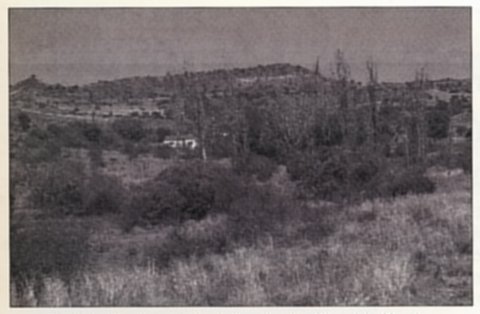
The Mokari farmhouse today, built on the site of the original farmhouse.
Plumer's column continued on its course southwards and, on 11 October, was sent by train back to Volksrust in the south-eastern Transvaal. Louis Wessels rejoined Kritzinger and, in December 1901, they crossed back into the Cape Colony, where misadventure befell Kritzinger. He was wounded, captured and faced a court martial, but survived to tell his story in a book written by his secretary. Wessels joined Smuts in the Western Cape and survived the war, intensely angered that Smuts had been party to an agreement to end the war. William Lilley was killed at Onverwacht on 4 January 1902 but his brother, David, returned home safely to his family.The fight at Mokari Drift was typical of the sharp engagements with small roving bands of Boers in late 1901. The British force was taken by surprise during this engagement, but there were other occasions when the reverse was true. Lieutenant Jack Caskey was mentioned in Lord Kitchener's despatch of 3 December 1901 (cited in The London Gazette) 'for great gallantry', but Alfred Pooley, who was equally brave, seems to have been forgotten. Lieutenant P L Tudor is mentioned in the same despatch for the action at Bastard's Drift.
Mokari today
The farmhouse is long gone and a newer farm building now occupies the spot where it once stood. The original gravesite is next to a little stream that seeps out of the dolerite and which provides the water supply for the house and its orchard of peach trees. There is an easy path from the garden up onto the flat-topped hill overlooking the Caledon River and the place where Caskey and Pooley and their men of the 5th QIB crossed over. Fording the river at this point is easy even by foot across a shelf of rocks, except when the river is in flood. The small ridges and gullies where Pooley and his men held out for all that time are easily discernable. They must have convinced themselves that there was no more than a handful of the enemy with whom to contend. It was disappointing not to find any spent cartridges - more than a century of rain seems to have washed them all away. And what happened to the two men of the Hampshire Regimentwho braved the hostile fire to bring ammunition to the defenders? There is no mention of them as casualties or prisoners. Perhaps they made their way back to safety after making their delivery.
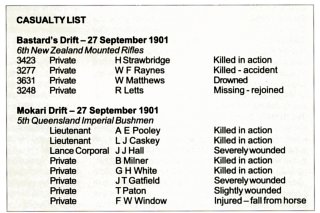
Return to Journal Index OR Society's Home page
South African Military History Society / scribe@samilitaryhistory.org